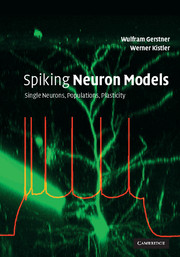Book contents
5 - Noise in spiking neuron models
Published online by Cambridge University Press: 05 June 2012
Summary
In vivo recordings of neuronal activity are characterized by a high degree of irregularity. The spike train of individual neurons is far from being periodic and relations between the firing patterns of several neurons seem to be random. If the electrical activity picked up by an extracellular electrode is made audible by a loudspeaker then we basically hear – noise. The question of whether this is indeed just noise or rather a highly efficient way of coding information cannot easily be answered. Listening to a computer modern or a fax machine might also leave the impression that this is just noise. Being able to decide whether we are witnessing the neuronal activity that is underlying the composition of a poem (or the electronic transmission of a love letter) and not just meaningless noise is one of the most burning problems in neuroscience.
Several experiments have been undertaken to tackle this problem. It seems as if neurons can react in a very reliable and reproducible manner to fluctuating currents that are injected via intracellular electrodes. As long as the same time course of the injected current is used the action potentials occur with precisely the same timing relative to the stimulation (Bryant and Segundo, 1976; Mainen and Sejnowski, 1995). A related phenomenon can be observed by using nonstationary sensory stimulation. Spatially uniform random flicker, for example, elicits more or less the same spike train in retinal ganglion cells if the same flicker sequence is presented again (Berry et al., 1997).
- Type
- Chapter
- Information
- Spiking Neuron ModelsSingle Neurons, Populations, Plasticity, pp. 147 - 200Publisher: Cambridge University PressPrint publication year: 2002
- 4
- Cited by



